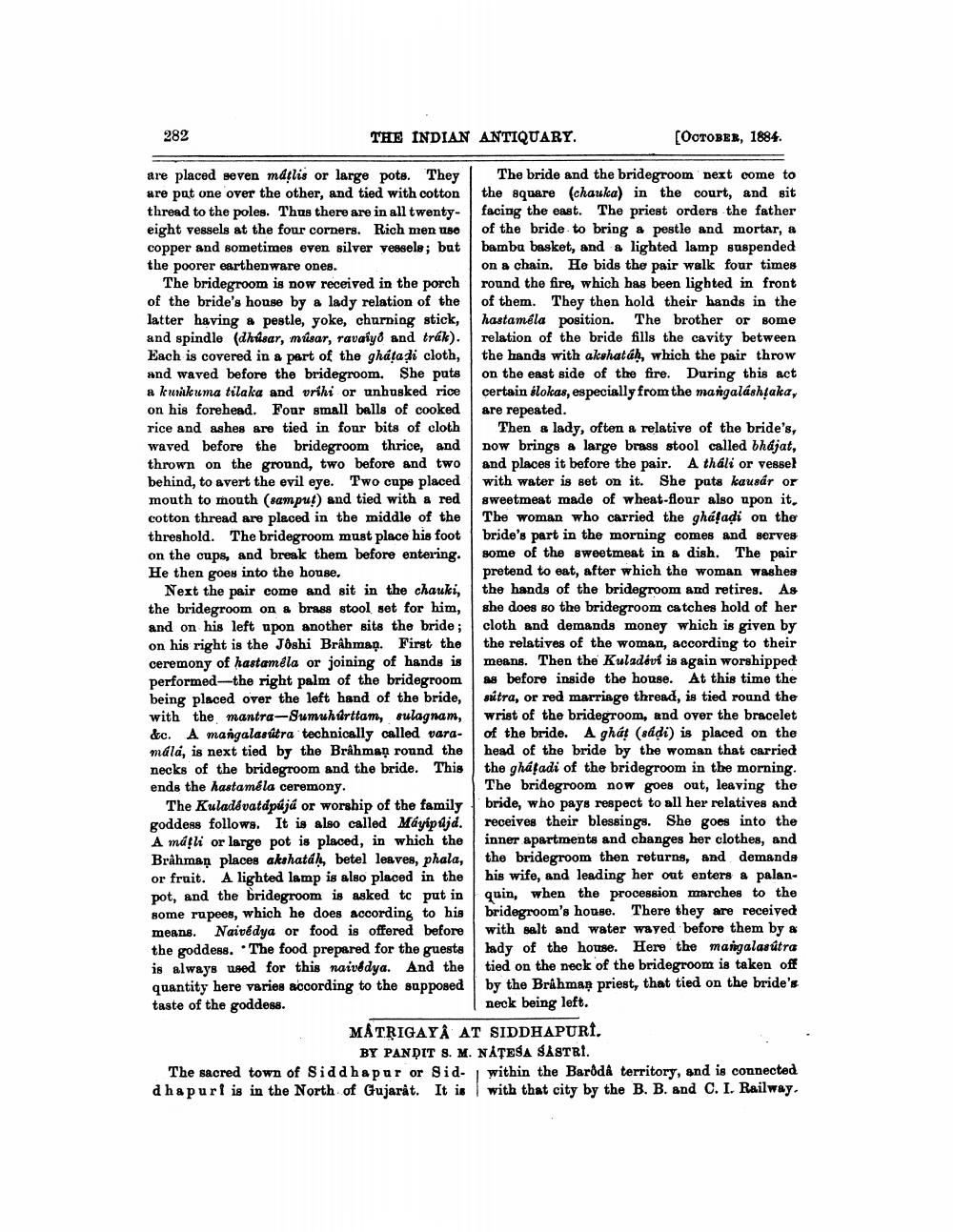________________
282
THE INDIAN ANTIQUARY.
[OCTOBER, 1884.
are placed seven mdflis or large pots. They The bride and the bridegroom next come to ure pat one over the other, and tied with cotton the square (chauka) in the court, and sit thread to the poles. Thus there are in all twenty- facing the east. The priest orders the father eight vessels at the four corners. Rich men use of the bride to bring a pestle and mortar, a copper and sometimes even silver vessele; but bamba basket, and a lighted lamp suspended the poorer earthenware ones.
on a chain. He bids the pair walk four times The bridegroom is now received in the porch round the fire, which has been lighted in front of the bride's house by a lady relation of the of them. They then hold their hands in the latter having a pestle, yoke, churning stick, hastamêla position. The brother or some and spindle (dhrlsar, misar, ravaiyð and trák). relation of the bride fills the cavity between Each is covered in a part of the ghata di cloth, the hands with akshatáh, which the pair throw and waved before the bridegroom. She puts on the east side of the fire. During this act a kurkuma tilaka and vrihi or unhusked rice certain ilokas, especially from the mangaláshịaka, on his forehead. Four small balls of cooked are repeated. rice and ashes are tied in four bits of cloth Then & lady, often a relative of the bride's, waved before the bridegroom thrice, and now brings a large brass stool called bhájat, thrown on the ground, two before and two and places it before the pair. A tháli or vessel behind, to avert the evil eye. Two cupe placed with water is set on it. She pats kausar or mouth to mouth (samput) and tied with a red sweetmeat made of wheat flour also upon it, cotton thread are placed in the middle of the The woman who carried the gháfadi on the threshold. The bridegroom must place his foot bride's part in the morning comes and serves on the cups, and break them before entering. some of the sweetmeat in a dish. The pair He then goes into the house,
pretend to eat, after which the woman washes Next the pair come and sit in the chauki, the hands of the bridegroom and retires. As the bridegroom on a brass stool set for him, she does so the bridegroom catches hold of her and on his left upon another sits the bride; cloth and demands money which is given by on his right is the Joshi BrAhman. First the the relatives of the woman, according to their ceremony of hastaméla or joining of hands is means. Then the Kuladevi is again worshipped performed the right palm of the bridegroom as before inside the house. At this time the being placed over the left hand of the bride, satra, or red marriage thread, is tied round the with the mantra-Sumuhúrttam, sulagnam, wrist of the bridegroom, and over the bracelet &c. A mangalasútra technically called vara- of the bride. A ghát (sådi) is placed on the máld, is next tied by the Brahmaņ round the head of the bride by the woman that carried necks of the bridegroom and the bride. This the gháfadi of the bridegroom in the morning. ends the hasta méla ceremony.
The bridegroom now goes out, leaving the The Kuladovatápújá or worship of the family! bride, who pays respect to all her relatives and goddess follows. It is also called Máyipújd. receives their blessings. She goes into the A másli or large pot is placed, in which the inner apartments and changes her clothes, and Brahman places akshatály, betel leaves, phala, the bridegroom then returns, and demands or fruit. A lighted lamp is also placed in the his wife, and leading her out enters a palanpot, and the bridegroom is asked to put inquin, when the procession marches to the some rupees, which he does according to his bridegroom's house. There they are received means. Naivedya or food is offered before with salt and water wayed before them by & the goddess. The food prepared for the guests lady of the house. Here the mangalasutra is always used for this naivedya. And the tied on the neck of the bridegroom is taken off quantity here varies according to the supposed by the Brahman priest, that tied on the bride's taste of the goddess.
neck being left. MATRIGAYA AT SIDDHAPURI.
BY PANDIT 8. M. NÅTESA SASTRI. The sacred town of Siddhapur or Sid. 1 within the Barðda territory, and is connected dhapurl is in the North of Gujarat. It is with that city by the B. B. and C. I. Railway.




